Promoting Health across the lifespan
Total Questions : 82
Showing 25 questions, Sign in for moreA nurse with a specialty in health informatics has been hired to be part of a team that is tasked with transitioning the hospital system from paper to electronic health records.
What might the challenges be in implementing this transition?
Explanation
The implementation of an electronic health record (EHR) system may result in a temporary loss of productivity during the transition phase.

Healthcare staff must be trained on how to use the new system, and it may take time for them to become proficient.
Additionally, existing paper-based records must be converted into digital format, which can be a time-consuming process.
Choice A is incorrect because while EHRs can lead to more efficient documentation, there may be an initial learning curve to navigate.
Choice C is incorrect because when implemented correctly, EHRs can improve patient safety and reduce medication errors.
Choice D is incorrect because the implementation of EHRs is a complex process that can present challenges.
Which one of the following phrases is a broad and inclusive definition of health informatics?
Explanation
Health informatics is a broad and inclusive field that involves the design, development, adoption, and application of IT-based innovations in healthcare services delivery, management, and planning.

Choice A refers to a specific documentation system used by nurses in hospitals, while choice B describes a specific method of patient follow-up care.
Choice D describes the use of electronic communication to improve patient health status, which is a component of health informatics, but it does not provide a comprehensive definition of the field as a whole.
What were the main focuses of the Triple Aim project?
Explanation
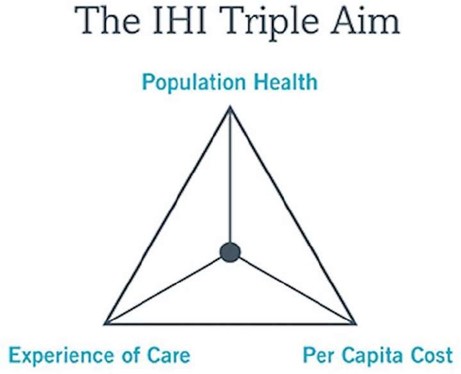
The Triple Aim project, developed by the Institute for Healthcare Improvement (IHI), is a framework that describes an approach to optimizing health system performance.
The IHI believes that new designs must be developed to simultaneously pursue three dimensions: improving the patient experience of care (including quality and satisfaction), improving the health of populations, and reducing the per capita cost of health care.
You are the nurse in a small town and are a member of a workgroup designing a multilevel intervention to decrease the violence in the community.
The group would like to use a theory that comprehensively assesses the health needs of the community but also serves as a guide to develop and evaluate the intervention.
What model would you recommend the group use?
Explanation
The PRECEDE-PROCEED model would be a good choice for the group to use.
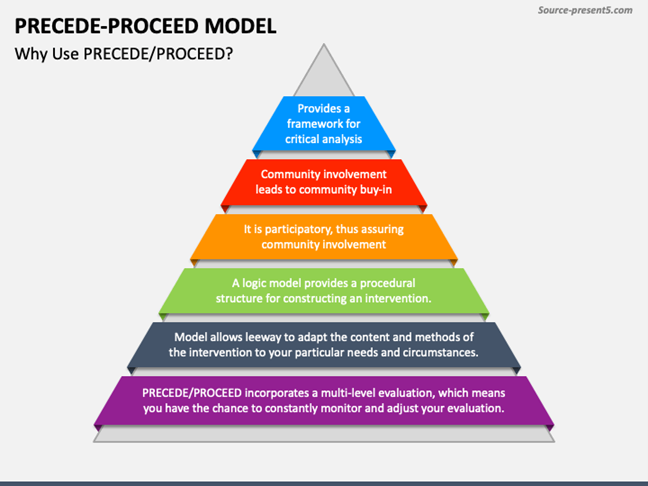
This model is a comprehensive structure for assessing health needs and designing, implementing, and evaluating health promotion and other public health programs.
It provides a framework for understanding the multifactorial nature of health and the multiple levels of intervention that may be needed to address complex health issues.
Choice A is incorrect because the Social Cognitive Theory focuses on the interaction between individuals and their environment, but does not provide a comprehensive framework for assessing community health needs.
Choice B is incorrect because the Diffusion of Innovation Theory focuses on how new ideas and technologies spread within a population, but does not provide a comprehensive framework for assessing community health needs.
Choice C is incorrect because the Health Belief Model focuses on individual beliefs and attitudes towards health behaviors, but does not provide a comprehensive framework for assessing community health needs.
Healthy People 2020 recognizes that a major thrust of the initiative should be a focus on age-related risks.
This means that:
Explanation
At each stage of life, there are different health problems and different preventative actions.
Healthy People 2020 has four overarching goals: Attain high-quality, longer lives free of preventable disease, disability, injury, and premature death; Achieve health equity, eliminate disparities, and improve the health of all groups; Create social and physical environments that promote good health for all; and Promote quality of life, healthy development, and healthy behaviors across all life stages.
Choice A is incorrect because age-related risks are a focus of Healthy People 2020.
Choice B is incorrect because age is considered when addressing health risks and preventative interventions.
Choice C is incorrect because each developmental stage has its own unique health problems and preventative actions.
Which of the following is a core competency for a health professional in the role of health promoter and educator?
Explanation
All of these are core competencies for a health professional in the role of health promoter and educator.
The ability to advocate on behalf of individuals and communities while building their capacity by incorporating an understanding of their assets, the ability to carry out efficient, culturally sensitive strategies to improve health, and the ability to assess the needs and assets in communities to analyze the behavioral, cultural, social, environmental, and organizational determinants of health are all important competencies for a health professional in this role.
Choices A, B, and C are all correct individually but choice D is the most comprehensive answer as it includes all of the competencies mentioned.
Why do people adopt or not adopt certain health behaviors, as explained by:
Explanation
Behavioral change theories explain why people adopt or not adopt certain health behaviors.
 These theories focus on a range of factors influencing behavior determinants, including factors within an individual (such as thoughts, feelings and beliefs), factors in groups or relationships, and factors that exist in organizations and communities (such as structures, regulations, policies and laws)1.
These theories focus on a range of factors influencing behavior determinants, including factors within an individual (such as thoughts, feelings and beliefs), factors in groups or relationships, and factors that exist in organizations and communities (such as structures, regulations, policies and laws)1.
Choice A is incorrect because environmental theories focus on the impact of the physical environment on health behaviors.
Choice B is incorrect because communication theories focus on how information is transmitted and received.
Choice D is incorrect because evaluation theories focus on assessing the effectiveness of interventions.
What is the most powerful input for confidence?
Explanation
Self-efficacy is the most powerful input for confidence.
Self-efficacy refers to an individual’s belief in their ability to succeed in specific situations or accomplish a task.
It plays a central role in the cognitive regulation of motivation, because people regulate the level and distribution of effort they will expend in accordance with the effects they are expecting from their actions.
Choice A is incorrect because anxiety can actually decrease confidence.
Choice B is incorrect because high levels of cortisol, a hormone released in response to stress, can also decrease confidence.
Choice D is incorrect because stress can also decrease confidence.
A school nurse planning a health promotion program at the school focuses on changing the determinants of health that, according to the CDC, account for 70% of premature deaths in the United States.
The determinants that account for 70% of premature deaths are:
Explanation
Health behaviors and the environment are the determinants that account for 70% of premature deaths in the United States according to the CDC.
The five leading causes of death in the United States are heart disease, cancer, chronic lower respiratory diseases, stroke, and unintentional injuries.
Together they accounted for 63 percent of all U.S. deaths in 2010.
Choice B is incorrect because access to healthcare is not one of the determinants that account for 70% of premature deaths.
Choice C is incorrect because genetics is not one of the determinants that account for 70% of premature deaths.
Choice D is incorrect because access to healthcare is not one of the determinants that account for 70% of premature deaths.
Health disparities include:
Explanation
Health disparities are differences in health outcomes or health risks that affect certain groups of people more than others.
These groups can be defined by factors such as race, ethnicity, gender, age, sexuality, income, education, disability, location or orientation.
Choice A is incorrect because it only includes ethnicity and age while health disparities can be defined by a variety of factors.
Choice C is incorrect because it only includes lack of a designated primary care provider while health disparities can be defined by a variety of factors.
Choice D is incorrect because it only includes lack of insurance while health disparities can be defined by a variety of factors.
Which of the following is the process of collecting and analyzing information?
Explanation
Evaluation is the act or result of judging something’s quality, importance, value, nature, character, or fitness.
It can be an appraisal, an assessment, or a diagnosis.
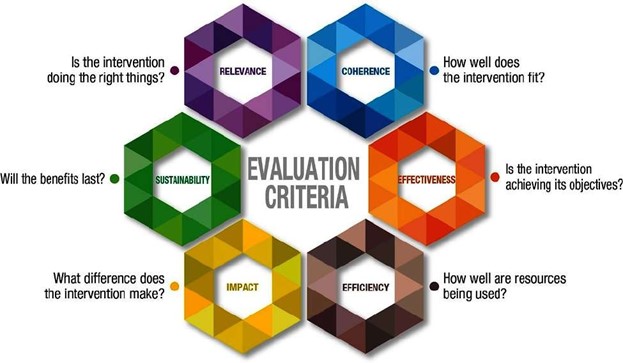
Choice B is incorrect because outcomes are the results or consequences of an action or event.
Choice C is incorrect because health promotion refers to the process of enabling people to increase control over their health and its determinants.
Choice D is incorrect because health education refers to the provision of information and instruction to individuals and communities about health- related topics.
Which of the following is the key difference between community health and population health?
Explanation
Community health is generally rooted in the collective efforts of individuals and organizations who work to promote health within a geographically or culturally defined group.
Choice A is incorrect because population health involves understanding health outcomes and the distribution of care for a group of people, which could be defined by demographic information, specific health needs, geographic location, or other factors.
Choice C is incorrect because community health is focused on a geographically or culturally defined group rather than an at-risk group of individuals.
Choice D is incorrect because only community health is focused on a geographic area while population health can be defined by a variety of factors.
True or False.
Teach-back can be used to assess a patient's understanding of instructions given by the nurse.
Explanation
The teach-back method is a way of confirming whether a patient or a care taker understands the medical information that a healthcare provider explains to them.
The patient or the care taker is asked to repeat or “teach-back” the information in their own words.
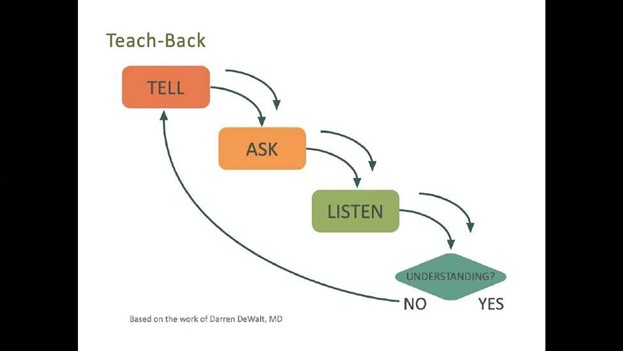
Choice B is incorrect because the teach-back method can be used to assess a patient’s understanding of instructions given by the nurse.
Which of the following are goals of health education?
Explanation
The goals of health education include improved health status, empowerment, and behavior change.
Health education aims to help people improve their health in all stages of life and make better health decisions.
It also strives to minimize the occurrence of life-threatening illnesses and fight common misconceptions that affect people’s health.
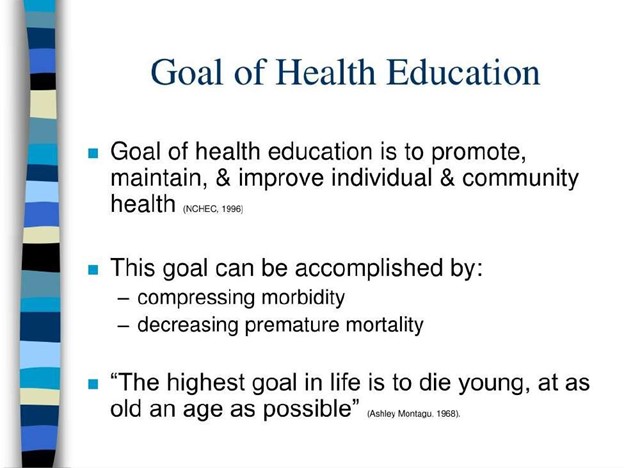
Choice A is incorrect because it only includes improved health status while there are other goals of health education.
Choice C is incorrect because it only includes empowerment while there are other goals of health education.
Choice D is incorrect because it only includes behavior change while there are other goals of health education.
Which of the following is not a type of learning based on Bloom's learning domains?
Explanation
Bloom’s Taxonomy comprises three learning domains: cognitive, affective, and psychomotor.

The cognitive domain focuses on knowledge and mental skills, the affective domain focuses on growth in feelings or emotional areas (attitude), and the psychomotor domain focuses on manual or physical skills.
Therefore, “Skills” is not one of Bloom’s learning domains.
Choice A, Knowledge is incorrect because it is part of the cognitive domain which focuses on knowledge and mental skills.
Choice B, Evaluation is incorrect because it is one of the levels of the cognitive domain.
Choice D, Attitude is incorrect because it is part of the affective domain which focuses on growth in feelings or emotional areas.
What is one of the best methods of assuring that a health promotion program is culturally appropriate?
Explanation
One of the best methods of assuring that a health promotion program is culturally appropriate is to involve members of the community in the planning and implementation process.
This can help ensure that the program is tailored to the specific needs and cultural values of the community it serves.
Choice B. Partnering with a nonprofit organization is incorrect because while it may be helpful, it does not necessarily ensure cultural appropriateness.
Choice C. Using governmental agencies as partners is incorrect because while it may be helpful, it does not necessarily ensure cultural appropriateness.
Choice D. Including a physician or a nurse on the planning committee is incorrect because while it may be helpful, it does not necessarily ensure cultural appropriateness.
Which verb is the most appropriate to use in a learning objective that will measure the patient's level of "understanding" of signs and symptoms of hypoglycemia (low blood sugar)?
Explanation
The verb “identify” is the most appropriate to use in a learning objective that will measure the patient’s level of “understanding” of signs and symptoms of hypoglycemia (low blood sugar).
This verb corresponds to the cognitive level of understanding or comprehension, which focuses on the ability to grasp or construct meaning from material.
- Inject is incorrect because it does not correspond to the cognitive level of understanding or comprehension.
- Design is incorrect because it does not correspond to the cognitive level of understanding or comprehension.
- Develop is incorrect because it does not correspond to the cognitive level of understanding or comprehension.
Which statement is the most accurate definition of the purpose of health education?
Explanation
The purpose of health education is to positively influence the health behavior of individuals and communities as well as the living and working conditions that influence their health.
Health education aims to provide individuals with the knowledge, skills, and motivation to make informed decisions about their health.
- To direct clients to change unhealthy behaviors is incorrect because it implies that health education is about telling people what to do rather than empowering them to make their own decisions.
- As health professionals, we are the most knowledgeable to give clients information is incorrect because it implies that health education is only about providing information rather than empowering individuals to make their own decisions.
- To ensure the clients do the best for their health is incorrect because it implies that health education is about telling people what is best for them rather than empowering them to make their own decisions.
The three primary types of learning are cognitive (knowledge), affective (feelings, attitude), and:
Explanation
The three primary types of learning are cognitive (knowledge), affective (feelings, attitude), and psychomotor (physical/kinesthetic).
Choice A, Cultural, is not a primary type of learning.
Choice C, Emotional, is not a primary type of learning as it is already covered under the affective domain which deals with feelings and attitudes.
A projected benefit of telemedicine or telehealth is that it may:
Explanation

Telemedicine or telehealth can improve the quality of present care by enabling providers to treat more patients across a wider geographic area, communicate and work together more easily with other providers, receive patient data more quickly and efficiently from other providers, deliver better coordinated and more effective care, and help patients avoid unnecessary emergency room or office visits.
Telemedicine can also reduce the expense of healthcare costs by providing cost savings and convenience.
Choice A is not a projected benefit of telemedicine.
Choice B is a projected benefit of telemedicine but it is not the only one. Choice C is a projected benefit of telemedicine but it is not the only one.
The principles of learning include all of the following except:
Explanation
The principles of learning include that information in written materials should be simple and bulleted when possible 1, information should be linked to the students’ current knowledge 1, and written material should be verbally reinforced with the students.
However, professional jargon is not a principle of learning.
Several nurses are working together on a health promotion program for clients in a low socioeconomic community.
What would be a major concern for these nurses when preparing the programs?
Explanation
When preparing health promotion programs for clients in a low socioeconomic community, a major concern for the nurses would be the level of health literacy in the group.
Health literacy refers to the ability to obtain, process, and understand basic health information and services needed to make appropriate health decisions.
Low health literacy can affect a person’s ability to understand and follow medical instructions, manage chronic conditions, and engage in self-care.
Choice A is not a major concern when preparing health promotion programs.
Choice B is not a major concern when preparing health promotion programs.
Choice C is not a major concern when preparing health promotion programs.
A nurse is planning on using the Rapid Estimates of Adult Literacy in Medicine (REALM).
The REALM is:
Explanation
The Rapid Estimates of Adult Literacy in Medicine (REALM) is a screening instrument used to assess an adult patient’s ability to read common medical words and lay terms for body parts and medical illnesses.
It is designed to help medical professionals estimate a patient’s literacy level so that appropriate patient education materials or oral instructions may be used.
Choice B is not what the REALM assesses.
Choice C is not what the REALM assesses.
Choice D is not what the REALM assesses.
What is NOT included in the principles of learning?
Explanation
Professional jargon is not included in the principles of learning.
The principles of learning are a set of characteristics research has found in successful classrooms and are designed to help educators analyze and improve teaching and learning for all students.
The use of professional jargon can hinder the learning process as it may not be easily understood by students.
Choice A is not the answer because information in written materials should be simple and bulleted when possible to aid in understanding.
Choice B is not the answer because information should be linked to the students’ current knowledge to help them build upon what they already know.
Choice D is not the answer because written material should be verbally reinforced with the students to help them better understand and retain the information.
When creating a health promotion material, at what grade level should it be made?
Explanation
Health promotion materials should be written at a second-grade level.
Most health care materials are written at a 10th-grade level or higher, which can make it difficult for some individuals to understand the information.
Choice A is not the answer because eleventh grade is too high of a reading level for health promotion materials.
Choice C is not the answer because fifth grade is also too high of a reading level for health promotion materials.
Choice D is not the answer because eighth grade is also too high of a reading level for health promotion materials.
Sign Up or Login to view all the 82 Questions on this Exam
Join over 100,000+ nursing students using Nursingprepexams’s science-backend flashcards, practice tests and expert solutions to improve their grades and reach their goals.
Sign Up Now

